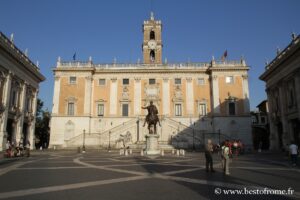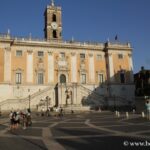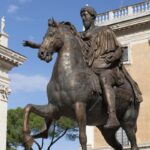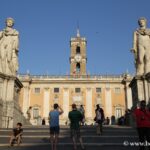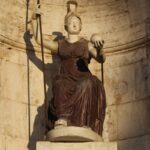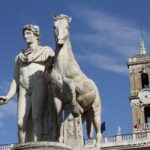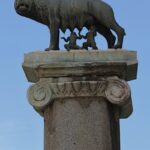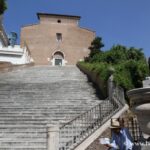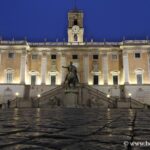In Italian: Piazza del Campidoglio
On the hill of the same name, the Capitoline Square is a masterpiece of harmony, designed by Michelangelo in the 16th century. It is also a peaceful place radiating energy and serenity. These grounds were, in fact, a religious sanctuary since the earliest days of Rome.
The visit to Capitoline Square ranks number 6 in our Top 30 things to see in Rome.
Overview and History, from Jupiter to Michelangelo
In antiquity, the Capitoline Hill was a significant place of worship dedicated to Roman deities, including Jupiter, with a vast temple that has since disappeared, leaving only a few underground remnants. Today, it serves as the seat of Rome’s city administration, with its palaces housing the Capitoline Museums, the city’s most important museum largely devoted to Roman antiquity.
The square was designed in the second half of the 16th century by Michelangelo. He redesigned the facades of the pre-existing palaces, created symmetry, and built the monumental staircase leading to it.
At the center stands a copy of the bronze equestrian statue of Marcus Aurelius (120-180), standing 2.7 meters tall. The original is housed in the nearby museum.
Almost square in shape, it is framed by three main buildings. The Senatorial Palace sits in the middle opposite, serving as Rome’s municipal seat and built atop the ancient Tabularium, which once stored Roman archives. It is preceded by a beautiful double-ramp staircase adorned with fine fountains featuring statues of the Tiber on the right, the Nile on the left, and the goddess Roma in the center.
On the south side, to the left of the previous one, the Palace of the Conservators was completed by Dalla Porta. It houses the Capitoline Pinacoteca of the museum. Opposite it, its twin, the Palazzo Nuovo, was built to make the square symmetrical. It was completed in the 17th century by the Rainaldi brothers. It hosts the other part of the museums, featuring ancient Hellenistic and Roman works. In the museum, one can pass from one palace to the other by crossing the Tabularium at the base of the Senatorial Palace.
The main staircase to access the square is the Cordonata Capitolina, also designed by Michelangelo, intended for use by horsemen. On either side, it is flanked by the two colossal statues of the demigod brothers Castor and Pollux, sons of Jupiter.
Another grand marble staircase leads to the porch of the medieval-origin church Santa Maria in Aracoeli, dating back to the 5th century and rebuilt in Roman-Gothic style by the Franciscans in the 13th century. An important fresco by Pinturicchio inside depicts the story of Saint Bernardino of Siena.
Photo Gallery of Capitoline Square
- Piazza del Campidoglio
- The Equestrian Statue of Marcus Aurelius
- Piazza del Campidoglio
- Statue of the goddess Rome
- Statue of Pollux
- Capitoline Wolf
- Stairs to Santa Maria in Aracoeli
- Capitol Square in the evening
Information and Map
Resources for Further Exploration
- Capitoline Museums
- Capitoline Square and Capitoline Hill on Rome-Roma, photos, history, and architecture
- Virtual Tour of the Square and Capitoline Museums
Where is Capitoline Square Located?
If you see this after your page is loaded completely, leafletJS files are missing.
Selection of Accommodations near Capitoline Square
Selections of hotels, rooms, and apartments near the Capitoline, sorted by price and by distance:
- Good hotels and accommodations sorted BY PRICE within 600 meters of Capitoline Square
- Good hotels and accommodations sorted BY DISTANCE from Capitoline Square
FAQ and Tips for Visiting
What to See Near Capitoline Square?
Plenty of attractions are nearby, all within walking distance:
- The view of the Roman Forum via di Monte Tarpeo, just behind the square
- Right next door: Santa Maria in Aracoeli on the Capitoline, along with the Capitoline Museums, then below, the Piazza Venezia, and the Monument to Victor Emmanuel II
- The Roman Forum (then the Colosseum and Palatine)
- The Theater of Marcellus, with the Ghetto beyond
- The Forum Boarium, including the Piazza della Bocca della Verità with the church and the ancient sewer mouth
- And more
What Are the Unique Features of the Equestrian Statue of Marcus Aurelius?
The equestrian statue of Marcus Aurelius at the center of the square is a copy of the original (fully restored), which is preserved in the Capitoline Museums. It is one of the few bronze sculptures from Roman antiquity to have survived. It depicts Emperor Marcus Aurelius, an emperor symbolizing power and wisdom. It endured so long because it was long mistaken for a statue of Constantine, a Christian emperor, as Christian authorities tended to preserve works linked to Christianity while destroying others.
The Café and Terrace
By taking Via delle Tre Pile to the right just after the staircase upon arriving at the square, on one side there’s a lovely terrace with a nice panorama, and on the other, you can enter the building to the left and climb the stairs to the café/restaurant with an even more panoramic terrace, the Terrazza Caffarelli.
What to Particularly See at Capitoline Square?
- Michelangelo’s architectural harmony: the symmetrical design of the square from the 16th century, including the facades of the three palaces (Senatorial, Conservators, and Nuovo) and the star-shaped pavement
- The equestrian statue of Marcus Aurelius
- The Cordonata Capitolina: The monumental staircase designed by Michelangelo, meant for horsemen, framed by the imposing statues of the Dioscuri (Castor and Pollux)
- The Capitoline Museums: They hold numerous treasures
- The fountains and statues of the Senatorial Palace: In front of the Senatorial Palace (city hall), stand the statues of the Tiber, the Nile, and the goddess Roma, before the majestic double-ramp staircase
- The Santa Maria in Aracoeli church: Accessible via a grand staircase next to the square or from the top of the square via the secondary entrance, preserving a fresco by Pinturicchio, among other features
- The view of the Roman Forum: From behind the Senatorial Palace, via Monte Tarpeo, enjoy a spectacular viewpoint over the Roman Forum, especially at sunset
Come Stroll in the Evening
In the evening, the square’s atmosphere seems to turn magical, perhaps thanks to the suggestive lighting, with few people around.








